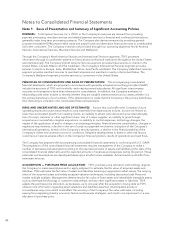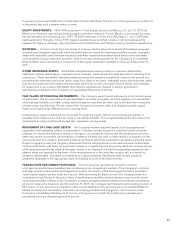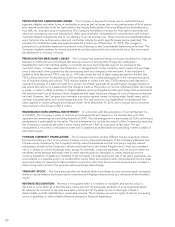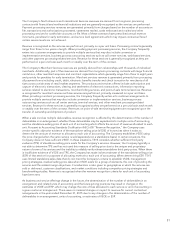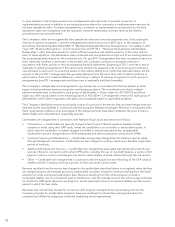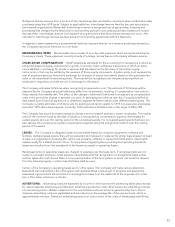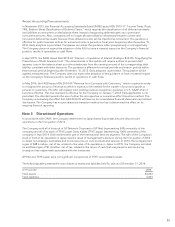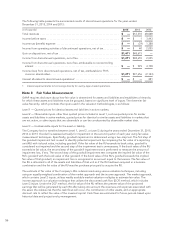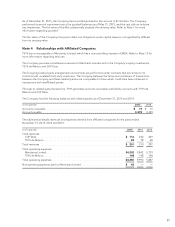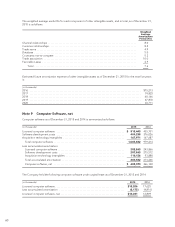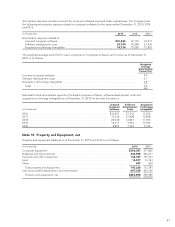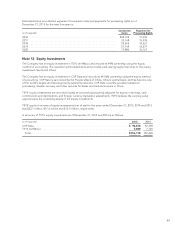NetSpend 2015 Annual Report Download - page 59
Download and view the complete annual report
Please find page 59 of the 2015 NetSpend annual report below. You can navigate through the pages in the report by either clicking on the pages listed below, or by using the keyword search tool below to find specific information within the annual report.
Recent Accounting Pronouncements
In November 2015, the Financial Accounting Standards Board (FASB) issued ASU 2015-17 “Income Taxes (Topic
740), Balance Sheet Classification of Deferred Taxes,” which requires the classification of all deferred tax assets
and liabilities as noncurrent on the balance sheet instead of separating deferred taxes into current and
noncurrent amounts. Also, companies will no longer allocate valuation allowances between current and
noncurrent deferred tax assets because those allowances also will be classified as noncurrent. The guidance is
effective for public business entities for annual and interim periods in fiscal years beginning after December 15,
2016. Early adoption is permitted. Companies can adopt the guidance either prospectively or retrospectively.
The Company does not expect the adoption of this ASU to have a material impact on the Company’s financial
position, results of operations or cash flows.
In April 2015, the FASB issued ASU 2015-03 “Interest — Imputation of Interest (Subtopic 835-30), Simplifying the
Presentation of Debt Issuance Cost.” The amendments in this update will require entities to present debt
issuance costs in the balance sheet as a direct deduction from the carrying amount of the corresponding debt
liability, consistent with debt discounts. The guidance is effective for annual periods and interim periods within
those annual periods beginning after December 15, 2015. Early adoption is permitted. The guidance will be
applied retrospectively. The Company does not expect the adoption of this guidance to have a material impact
on the Company’s financial position, results of operations or cash flows.
In May 2014, the FASB issued ASU 2014-09 “Revenue from Contracts with Customers,” which requires an entity
to recognize the amount of revenue to which it expects to be entitled for the transfer of promised goods or
services to customers. The ASU will replace most existing revenue recognition guidance in U.S. GAAP when it
becomes effective. The new standard is effective for the Company on January 1, 2018. Early application is not
permitted. The standard permits the use of either the retrospective or cumulative effect transition method. The
Company is evaluating the effect that ASU 2014-09 will have on its consolidated financial statements and related
disclosures. The Company has not yet selected a transition method nor has it determined the effect on its
ongoing financial reporting.
Note 2 Discontinued Operations
In accordance with GAAP, the Company determined its Japan-based businesses became discontinued
operations in the first quarter of 2014.
The Company sold all of its stock of GP Network Corporation (GP Net) (representing 54% ownership of the
company) and all of its stock of TSYS Japan Godo Kaisha (TSYS Japan) (representing 100% ownership of the
company) in April 2014. Both entities were part of the International Services segment. The sale of the Company’s
stock in both of its operations in Japan was the result of management’s decision during the first quarter of 2014
to divest non-strategic businesses and focus resources on core products and services. In 2014, the Company had
a gain of $48.6 million, net of tax, related to the sales of its operations in Japan. In 2015, the Company recorded
an additional gain of $1.4 million, net of tax, related to the return of cash that was placed in escrow during
closing and tax adjustments associated with the transaction.
GP Net and TSYS Japan were not significant components of TSYS’ consolidated results.
The following table presents the main classes of assets and liabilities held for sale as of December 31, 2014:
(in thousands) 2014
Total assets .............................................................................. $4,003
Total liabilities ........................................................................... 4,003
55



